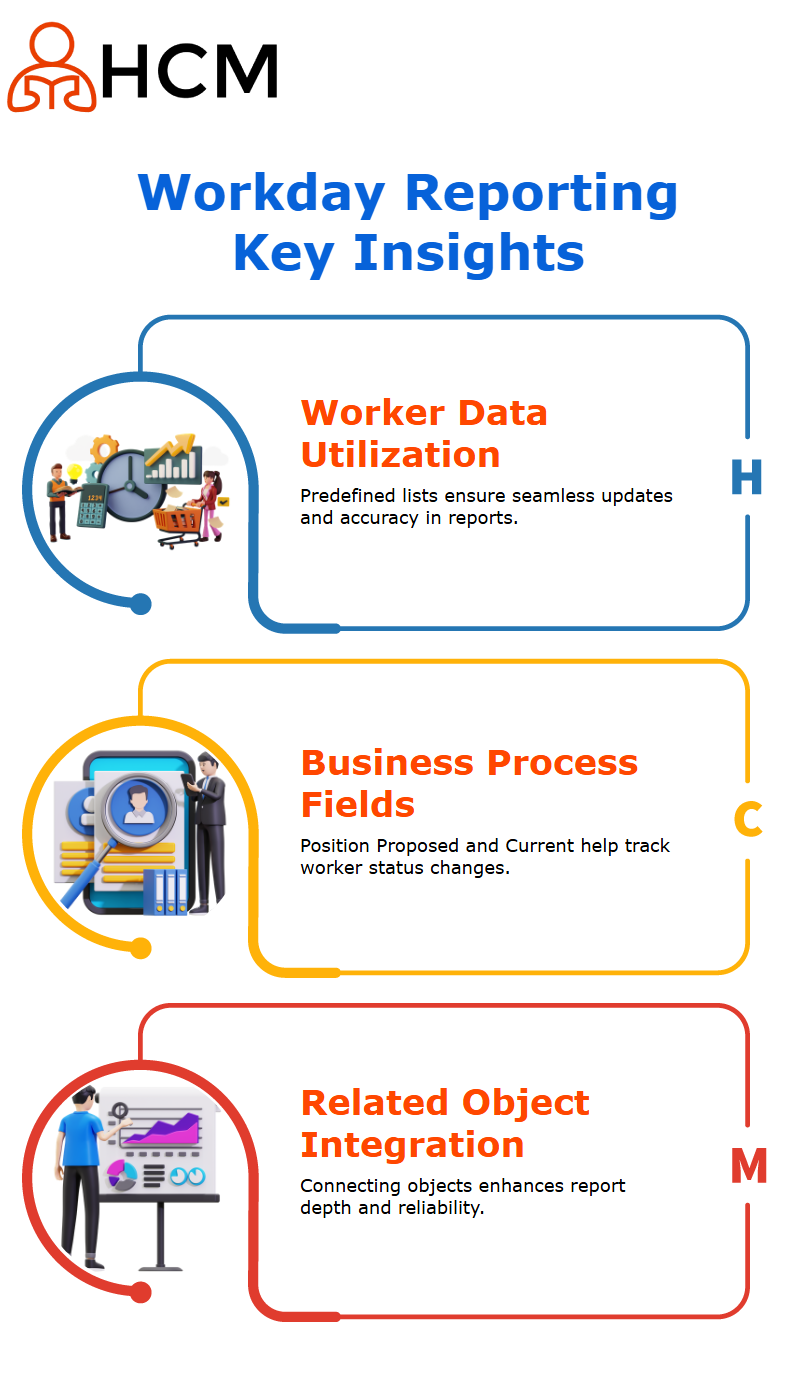Hyderabad’s #1 Choice for Workday Training in Hyderabad {2025}
Workday Reporting Course in Hyderabad
Topic Overview
Workday Reporting allows you to create dashboards, leverage embedded analytics, and generate impactful insights beyond what would otherwise be available to you.
Our experts discussed various reports, including advanced, simple, transposed search, and composite reports, providing your teams with everything they need for maximum productivity.
Each has unique strengths explicitly tailored for different Workday Reporting needs truly remarkable considering its flexibility! Demystifying Workday Reporting Objects:
A key takeaway was learning the distinctions between primary business objects (PBOS) and related business objects (RBOS) within this tool.
PBOS are created directly from data sources and serve as the building block of most fields; on the other hand, RBOS must be accessed through PBOS to gain access.
Understanding this difference between them is vital in mastering Workday Reporting.
Exploring Business Process Transactions in Workday Reporting
The Workday Reporting Course in Hyderabad emphasises the importance of this data source, as Workday Reporting relies heavily on it as the foundation for creating reports that encompass events related to business processes, such as hiring, terminations, promotions, salary adjustments, and merit plan updates.
All such transactions fall under Workday Reporting’s purview, as they are business process transactions that require accurate and timely reporting.
Let me know if you’d like the tone adjusted (e.g., more formal or instructional).
Building reports utilising business process transactional data sources provides invaluable insight into various events occurring within Workday and is an engaging method to bring structure to transactional information.
It offers two types of data sources: standard and indexed. Standard sources tend to take longer to process and display results than their indexed counterparts, making them slower-performing options.
Indexed data sources offer faster run times and output than their non-indexed counterparts, making choosing them essential when designing reports.
Choosing between them can make a significant, impactful difference when crafting reports.
How to Utilise Workday Reporting?
It allows us to explore business process transaction data sources. Every data source contains one primary business object, which serves as the foundation of all our reports.
Think of it as the central hub where all fields (standard or calculated ones) come together, or related business objects can provide them. Seems easy enough?
Let me break it down for you: The Workday Reporting Course in Hyderabad highlights how Workday Reporting provides fields like ‘about worker’ to display information regarding workers involved with transactions; ‘action event’ provides details regarding when events were carried out, while ‘all comments’ collects all remarks added during review or approval steps—making Workday Reporting an incredible asset in uncovering insights!

Exploring Workday Reporting Tabs
Navigating Workday Reporting’s tabs becomes simple once you know where to look for what you need.
For instance, the “Fields” tab provides access to data that is directly delivered and/or calculated throughout its creation process.
The Workday Reporting Course in Hyderabad also walks you through the “Descriptions” subsection, which details what each field offers, making it even easier to select which fields to include.
Its related business objects also deserve special recognition. When working on a transaction report for business processes, all fields linked directly to their primary object will be instantly available for use.
However, for reports covering wider topics or applications, related objects open up an exciting world of possibilities that truly extend their capabilities and depth.
Workday Reporting truly stands out as a versatile solution that offers both flexibility and depth simultaneously.
Workday Reporting and Business Objects
It is an invaluable tool that organizes and makes sense of complex data stored across multiple business objects.
While most fields used in reports originate directly from one object, other business objects may also contain relevant fields for reporting purposes. Let me provide an example to illustrate my point.
Imagine you’re dealing with position changes within Workday Reporting. Each time a transaction occurs, it may involve adjusting values such as salary, manager salary, or organisational structure. This field represents what existed previously and what has changed since.
The Workday Reporting Course in Hyderabad explains how Workday Reporting enables users to explore this option, where the proposed position field may not directly relate to its primary business object, which in this instance is an action event.
Navigating Related Business Objects in Workday Reporting
Now comes a key part of Workday Reporting finding the correct business object. Say your position proposed field relies on worker business process rather than action event for its data source.
To accurately pull its field into your report you must identify whether worker business process relates to this particular action event and, if it does, seamlessly incorporate worker business process as one of its related objects into the report itself.
Workday Reporting offers powerful tools, like tabs that display “Links to Related Business Objects” and ‘Links from Related Business Objects,” that enable you to explore which secondary objects may connect back to a primary one.
For instance, you could filter on worker business processes and view all fields available that can be included into a report.
Enhancing Reports in Workday Reporting with Calculated Fields
Workday Reporting doesn’t always allow users to pull related business object fields directly, such as for matrix or trending reports.
Here, calculated fields come into play, providing data from secondary business objects within your primary view.
I won’t delve too deeply into creating calculated fields at this point, but it can unlock all the possibilities within Workday Reporting.

Worker-Delivered Data and Its Role in Workday Reporting
The Workday Reporting Course in Hyderabad emphasises how Workday Reporting relies heavily on worker-delivered data structures.
These predefined lists and items can be utilized within reports without manipulation or alteration for instance, you might encounter lists with up to 298 items that update automatically during system upgrades.
It enables these updates to occur seamlessly in the background, allowing us to focus on creating impactful reports without worrying about unreliability or the need to manually update them.
Understanding Workday Reporting's Worker Business Processes
The Workday Reporting course provides essential data about worker business processes. When selecting fields to include in a report, consider your requirements when choosing from among these options.
For instance, if your report focuses on service date business processes, then select that field. Alternatively, if it ties more closely to worker-related ones, use those fields instead.
There are two key fields, Position Proposed and Current, that represent worker positions before business processes begin and after they conclude, respectively.
With an understanding of these fields, you can more efficiently build reports in the Workday Reporting course in Hyderabad.
It allows users to analyse related business objects. For instance, opening the worker business process object as an independent tab makes it easier to evaluate and understand its contributions to reports.
Tabs inside this object provide insights into its available fields and their importance.
Let’s delve deeper into Workday Reporting using an example. Let’s assume you’re creating a report where Worker Business Process is the main view. By scrutinising all details, you may identify unrelated business objects that could add more value.
Filtering for specific fields, such as Position Proposed and Current, ensures that only relevant information remains.
This enables users to link related business objects, resulting in comprehensive and accurate reports.
When the Action Event is the primary object, any related objects listed under its tabs should be utilised; conversely, if the Beneficiary Event is the focus, checking if Action Event fields can be included ensures that an in-depth and reliable account of what was going on during its production is achieved.
As you explore Workday Reporting, you may notice that specific reports use indexed data sources while others utilise standard ones.
When creating either advanced or straightforward reports, understanding how your data source functions is key for efficient report creation.
Advanced Insights and Practical Applications in Workday Reporting: To create reports more efficiently, Workday Reporting requires a close examination of both primary and secondary business objects.
Understanding their structures provides a structured method for report production; regardless of whether your primary business object is an Action Event or a Beneficiary Event, their associated fields offer valuable insights.
Offers flexible options for creating advanced reports. Calculated fields or pulling information from related business objects allow for the customisation of reports explicitly suited to individual needs.
Tabs within business objects make selecting appropriate data fields simple, ensuring your report meets all your requirements.
Emphasises evaluating object models before creating reports. Doing this enables you to quickly locate fields available directly from data sources or through related business objects and assess them all efficiently for report writing purposes.
By considering all your available options for building reports efficiently.
As part of the Workday Reporting report-building process, it’s vitally important that you consider both primary and secondary business objects when creating reports.
Examining the Action Event’s associated business objects reveals fields that could potentially enhance the report; understanding Beneficiary Event links ensures that you incorporate essential data effectively.

Exploring Data Sources in Workday Reporting
It enables users to utilise both standard and index data sources when creating matrix reports. In contrast, search and inbox reports must only utilise index sources; any attempt to build them using other sources will be unsuccessful, as Workday does not permit it.
Transpose reports, however, can use either standard or index sources when creating them. Composite reports in the Workday reporting course in Hyderabad stand out because they’re built without using data sources as building blocks.
I will demonstrate how composite reports operate differently during sessions on them and highlight why they don’t rely on any specific source an essential distinction when using Workday Reporting effectively.
Business Object Detail Reports in Workday Reporting
A personal favourite feature of Workday Reporting for me is its Business Object Detail report, an invaluable way to explore delivered features and understand business objects without getting lost among the multitude of options.
If you are searching for journal related business objects, start by typing the word ‘journal’ into the search bar of Workday Reporting.
This will present various business objects related to this query and allow you to delve deeper by selecting a journal line, which opens a detailed view of fields, calculated values, RBOs and data sources plus there will also be standard reports designed specifically around journal lines that aim to make your reporting journey smoother!
Exploring Standard Reports in Workday Reporting: Another powerful feature in Workday Reporting is its ‘standard reports’ tool.
Before creating new reports from scratch, always explore existing standard ones first, if possible. For instance, when working with expense line reports, you can check financial accounting or expense categories, as these typically contain lists of preloaded standard reports explicitly tailored for expense management.
Under ‘Expenses,’ you can quickly access reports with their names, definitions and tailoring to meet your individual needs.
Report writers can modify their reports. For Espresso reports, only the output is visible; Workday Reporting makes this distinction clear for easier understanding.
Workday Reporting for Security Groups
“Let me show you how the Workday Reporting course in Hyderabad works when evaluating security groups. Let’s assume you want to find which domain allows you to run the standard report for average expense cycle types.
Clicking any given domain allows you to see its list of security groups that have access. Selecting ‘View Security Policy Option’ allows for even easier identification of which groups have the capabilities to run similar reports.
If these security groups meet your requirements, great! Otherwise, please consult with your security team so they can grant access.
Workday Reporting and Security Group Configuration
Setting up Workday Reporting doesn’t need to be complex. Once you know which security groups and access are necessary for reporting purposes, setup is straightforward.
When configurations depart from standard methodologies, however, applying logic becomes essential.
Workday Reporting may prove both straightforward and challenging, depending on its complexity, but with a proper approach, it can still be manageable.
The Workday Reporting course in Hyderabad can guide beginners through these complexities with structured insights and practical examples.
The Security Team plays a crucial role. They create security groups and assign access according to individual requirements and needs.
Workday accommodates various types of security groups, which are explicitly tailored to meet each specific security need.
As a beginner in Workday Reporting, the Data Sources report can be highly beneficial. It presents all available data sources within Workday, providing an overview of everything at your disposal.
If creating reports requires using certain ones but you don’t yet understand their permissions, security groups, or filters, this report is the way forward.
Workday Reporting makes exploring data sources easy. From finance-related sources like adjustment lines, plans, and print runs to standard or indexed sources with inbuilt prompts for every data source available, Workday Reporting gives you all of the tools to explore data with confidence! Filters may either apply automatically or require manual adjustments for precise results.
Enrolling in a Workday Reporting course in Hyderabad helps users leverage the Data Sources report to jump-start report creation, offering insight into fundamental principles while effectively utilising Workday’s features.


Vishwak
I write because the fight to learn is just as crucial as the knowledge acquired; every click, every mistake, every little success.
